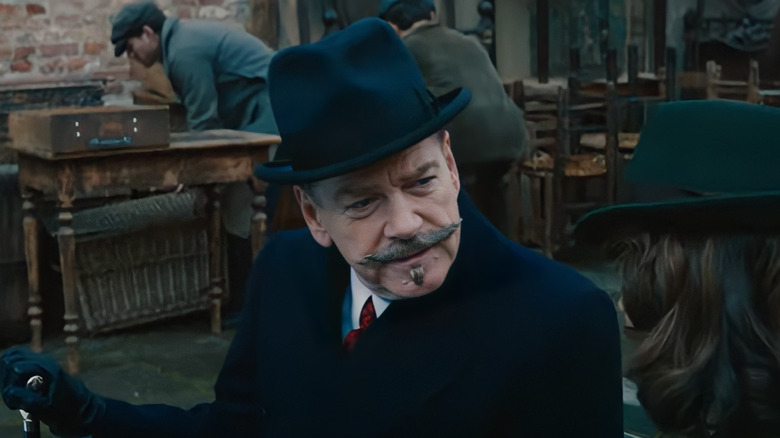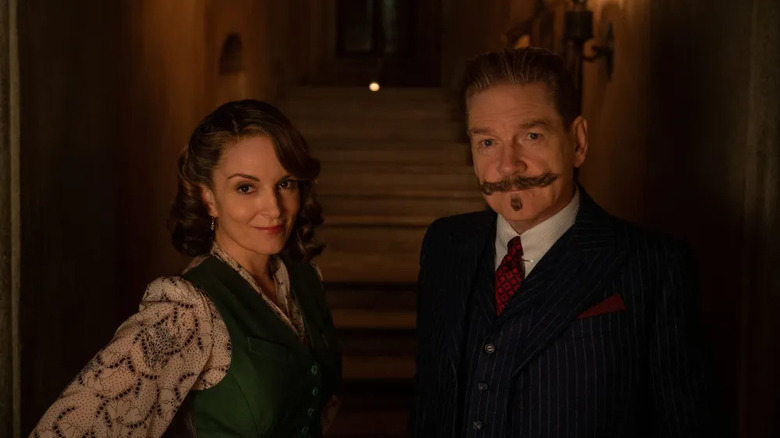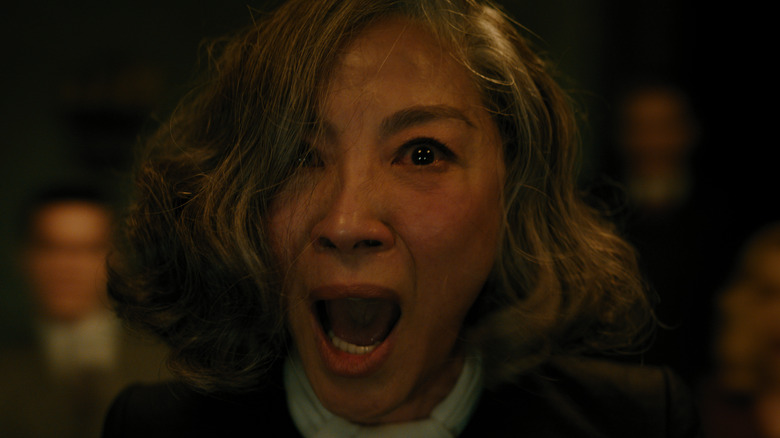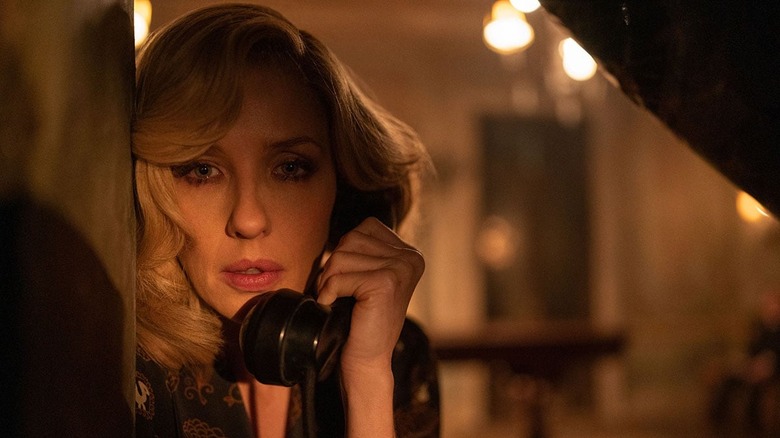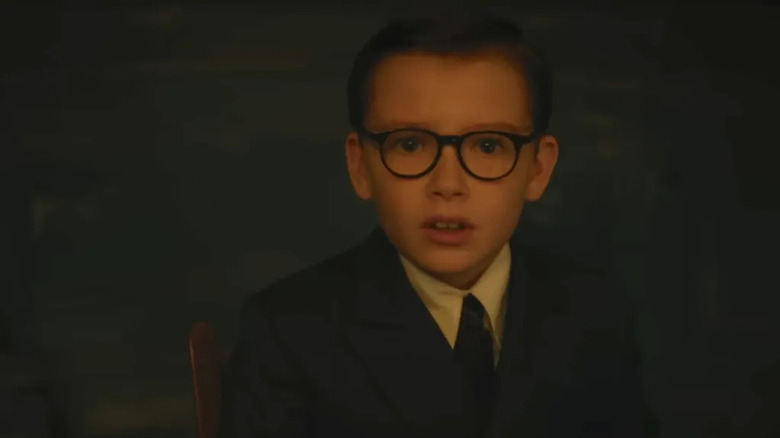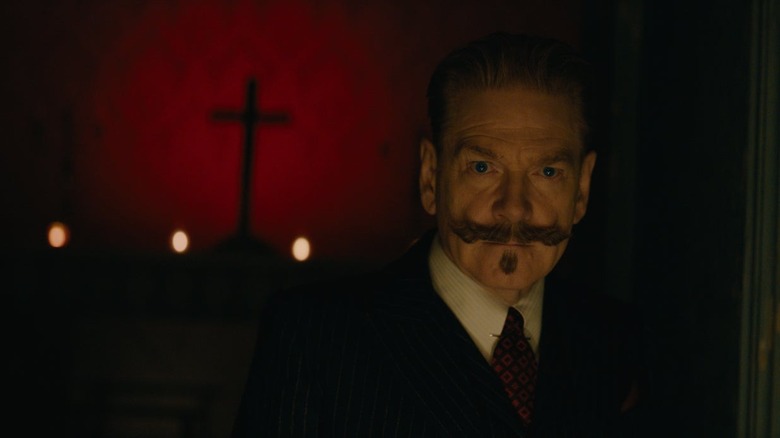The Four Biggest Things A Haunting In Venice Actually Keeps From Its Source Material
Major spoilers below for both "A Haunting in Venice" and Agatha Christie's "The Hallowe'en Party."
Officially, "A Haunting in Venice" is an adaptation of Agatha Christie's 1969 novel "The Hallowe'en Party," but is it really? The book has a different setting, a different (sort of) killer, a different motive, a different inciting incident, different themes, and a completely different atmosphere. There is no séance in the book, nor is Poirot ever forced to question whether or not he truly believes in the supernatural.
It naturally leads to the question of why director Kenneth Branagh and screenwriter Michael Green even bothered to make an adaptation of this book in the first place. Wouldn't it have been easier to not credit a specific book at all, and just say this movie was inspired by Christie's books in general? Why say you're adapting "The Hallowe'en Party" if you're not going to keep anything from it?
But on closer inspection, "A Haunting in Venice" does at least manage to include a few key elements from the book. It might present these elements in completely different orders and in whole other contexts, but those elements have still survived the switch in mediums. Some of them are pretty minor — a few characters keep their names from the book — and there's still a Halloween Party in the beginning, but others are absolutely vital to the story this movie's trying to tell.
The apples are still here
Bobbing for apples is a fun game, if perhaps an old-fashioned one. I heard some confused laughter in my theater during the scene where Poirot dips his head into the pool of apples and tries to catch one with his mouth, and it makes sense: If you've never seen or heard of this game before, this all looks weird and goofy. But it is a real game people played (and still play) at parties, especially in the early twentieth century where this movie takes place.
Poirot's near-drowning in the tub of apple water is also one of the movie's most blatant call-outs to the book. Although Poirot survives his drowning, in the book it's a 13-year-old girl who gets her head forced under the water, and she's not so lucky. The girl in question is Joyce Reynolds, who loudly proclaims earlier in the book that she's seen a murder, and is murdered herself soon after. It turns out she was lying about what she saw, simply borrowing a story she heard from a close friend of hers, but the killer took her at her word and killed her before she could reveal more.
The apples become a recurring motif in the book after this point, with Ariadne Oliver (played in the film by Tina Fey) declaring that she doesn't think she'll eat an apple again. The apple motif returns for the movie, but with a slightly different context. Apples are still intended as a sign of danger and lurking evil, except the movie's version of Oliver still loves apples and never swears off them. For those who've read the book, this character detail serves as fun foreshadowing for the change in her character; unlike book Oliver, this version of the character is not as innocent or straightforward as she appears.
Joyce Reynolds still gets murdered
In the movie, Joyce Reynolds is a grown woman, a supposed psychic played by Michelle Yeoh who also claims to know about a murder. This version of Joyce is both more respected by most of the other characters and seemingly a lot more intelligent, and yet she too is killed for the same basic reason: She lies about knowing the murderer of a long-deceased person. The murderer, not knowing they've actually got nothing to worry about, goes and kills her anyway.
What's particularly interesting about Yeoh's version of Joyce Reynolds is that, as different as she seems on the surface from her book counterpart, the core of the character stays true. She's a person who wants to seem unique and all-knowing, the center of attention. Like book Joyce, she makes a big declarative statement that she's not actually able to back up in any substantial way. If she hadn't been killed before the next part of the séance, it's not clear exactly how she would've handled things. If the killer had waited a little bit, Joyce almost certainly would've revealed herself as a fraud by the end.
In a darkly ironic sort of way, both Joyces get what they want with their unfortunate demises. Their murders gave their lies a false sense of legitimacy; book Joyce was frustrated that nobody took her claims seriously, and it was only after she died that people finally did. Likewise, movie Joyce spends most of her time alive trying to convince Poirot that she's a real psychic, but it's only when the murderer needlessly kills her that Poirot's worldview is finally shaken.
The killer is still willing to sacrifice their own family
The final act of "A Haunting in Venice" reveals the killer to be none other than Rowena Drake (Kelly Reilly). On paper this sounds like it's been straightforwardly taken from the book, as Mrs. Drake is one of the murderers there. But this version of Mrs. Drake acts entirely on her own, and her motivations are completely different. In the book, Mrs. Drake worked with her gardener Michael Garfield to kill Olga Seminoff a while before the book begins, and it's that murder that Mrs. Drake believes Joyce witnessed. In the movie, there is no Michael Garfield, and Olga Seminoff (Camille Cottin) remains alive throughout the entire thing. Whereas book Mrs. Drake killed Olga for money reasons, movie Mrs. Drake kills her own daughter by accident. She'd been poisoning her daughter with an obscure type of honey to keep her weak and dependent on her mother, but the fatal overdose wasn't planned.
Although the honey reveal was never in the book, Mrs. Drake's treatment of her daughter takes perhaps the clearest inspiration from it. The end of "The Hallowe'en Party" revolves around the gardener Garfield deciding to kill his daughter Miranda for his own selfish reasons. In a book already filled with child murders, this act of Garfield's is considered particularly heinous because it's his own child he's killing. The characters are all understandably perplexed by the idea of a parent wanting to harm their own child; in the movie, their inability to imagine such cruelty is a big part of what allows this version of Mrs. Drake to get away with the murder for as long as she did.
Leopold is still sort of a creep
One of the biggest surprises for Christie fans is the way "A Haunting in Venice" spares the life of young Leopold (Jude Hill), who was the book's second child to be murdered via drowning. Movie Leopold doesn't just get to live; he gets to spend far more time interacting with Poirot throughout the entire story. But just like in the book, Leopold is weird, unsettling, and seems to know far more than he's letting on.
The biggest thing kept about Leopold between mediums is the fact that he's a blackmailer. Book Leopold witnesses Mrs. Drake murdering his sister Joyce, but chooses to blackmail the woman instead of going straight to the authorities. His greed is quickly punished, as Mrs. Drake and Michael Garfield decide he's far too risky to be left alive. Movie Leopold's motivations are far more central to the plot of story: he's figured out Mrs. Drake killed her daughter long before the movie begins, and it's his constant blackmailing of her that's put her in the desperate financial state we see her in at the start. If it weren't for Leopold, nobody else here would've died at all.
Leopold and Poirot end the movie on a fairly optimistic note, with Leopold using the blackmail money to pay for the Holland siblings' trip to America. Poirot seems to have forgiven Leopold for his crimes, but it doesn't quite make up for the creepy vibes the kid gives off. His new guardian Olga is going to have her work cut out for her.
Why'd they change so much, anyway?
Most of the time, movie adaptations end up spurring list articles that focus on what was changed from the book, but "A Haunting in Venice" changes so much that it's far easier to just focus on the few elements that stuck around. Even among the four things mentioned here, each of them have major caveats.
Yet it's hard to blame the movie for its many, many adaptive flourishes, because "The Hallowe'en Party" was not a particularly good book. It was a fairly run-of-the-mill mystery, one where the reveal seemed needlessly complicated. Perhaps most damning of all, the killers don't even get to be in the room for Poirot's big monologue, and that's half the fun of a whodunnit in the first place. "The Hallowe'en Party" is not a book anyone feels protective over; whereas the "Harry Potter" films knew they'd be angering millions of Potterheads with any change they made, this book won't have many defenders sending Kenneth Branagh hate mail over his movie's many omissions.
"Bad books and bad plays make really good movies," prolific screenwriter Eric Roth said a few years back, and after watching Branagh's third Poirot film — the best one despite being based off easily the weakest novel of the three — it's easy to see his point. Every big change in "A Haunting of Venice" served to make for a more thematically coherent story, one with more compelling characters and far fewer abandoned plot threads. There's a lot of freedom that comes with adapting a book nobody particularly loves, and Branagh's latest film takes full advantage.
"A Haunting in Venice" is currently showing in theaters.
